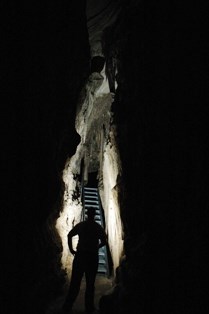
NPS PHOTO Walking Through the Fractured EarthThe location of faults controlled the creation of some of the cave passageways in Lehman Caves. Cave passages tend to follow a fault for a short distance, then branch off of it. Faults may be open or closed, meaning there may be space between the moving walls or not. Cave passages may develop along open faults because there is a space for the water to enter. If a fault is only open for a short distance, a cave passage may develop in this section, but the passage will not extend into the closed section of the fault. The Rocky Road, the Music Room, and the Royal Gorge sections of Lehman Caves are examples of passageways that developed along faults.EarthquakesAny mention of faults usually results in questions about earthquakes. It does not seem that the faults in the cave have been active for a long time. If there were earth movement along one of them, it would probably cause some shifting in the cave. Earthquakes generated by movement along faults further away do not seem to cause damage in the cave, even when they shake the surface. Earthquakes generate three different types of waves, which travel in different ways. The undulating motion waves travel along the surface and can cause a lot of damage. Sound waves generated by earthquakes can travel at deeper depths. It is sometimes possible to hear an earthquake while in a cave. The sheer number of formations in Lehman Caves, and their large size, is evidence that not much shifting has happened in most of the Cave for a long time. The one exception is the Talus Room.The Talus RoomThe rockfalls in the Talus Room may or may not have been triggered by earthquakes. Most collapse in caves happens either when the water first drains out of the cave or when the surface finally erodes too close to the roof of the cave. When a cave passageway is filled with water, the water creates bouyancy, and actually supports the cave ceilings. Once the passageways drain, this support is lost, and can cause rocks to fall, creating large piles of talus boulders, or breakdown on the cave floors.Not much has happened the weaken the strength of the bedrock since the water table lowered. Yet the water that filled the cave was also giving a little support for the weight of the ceiling. The Talus Room probably started to collapse once water drained from this part of the cave. It has not reached a stable point yet, probably because of the room's size, although the fault zones have played a role as well. As a result, there are probably old cave passageways buried beneath the breakdown rubble in the Talus Room. |
Last updated: May 26, 2023
